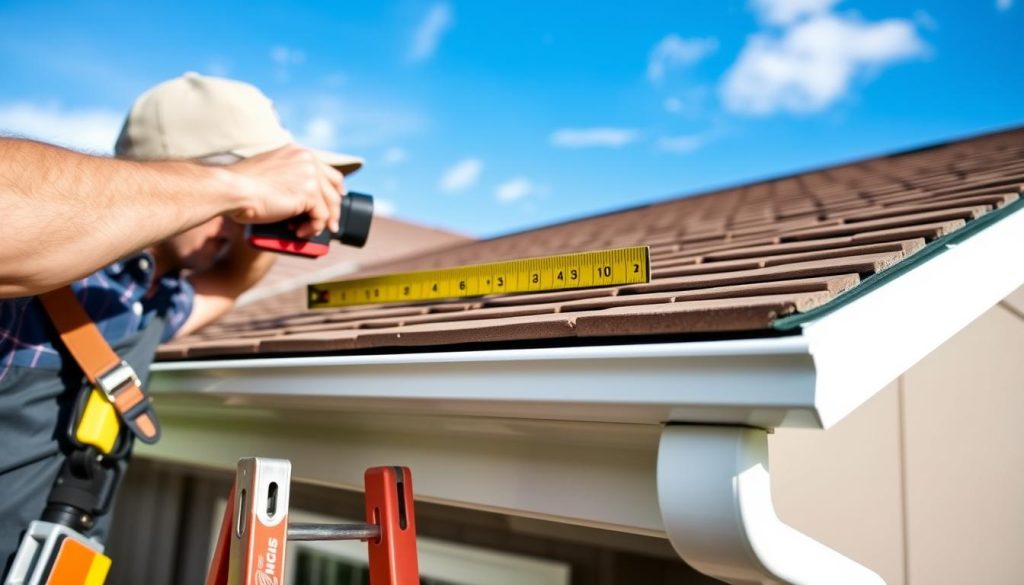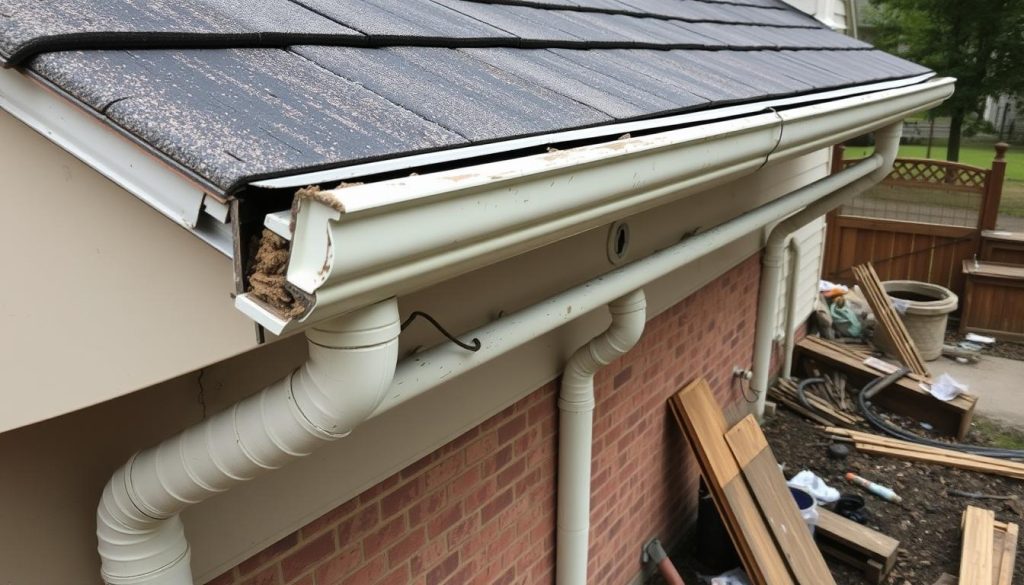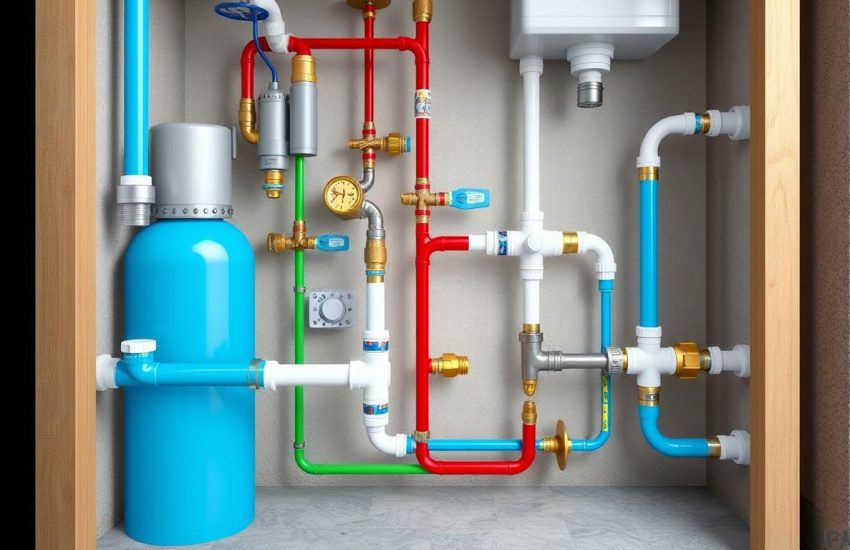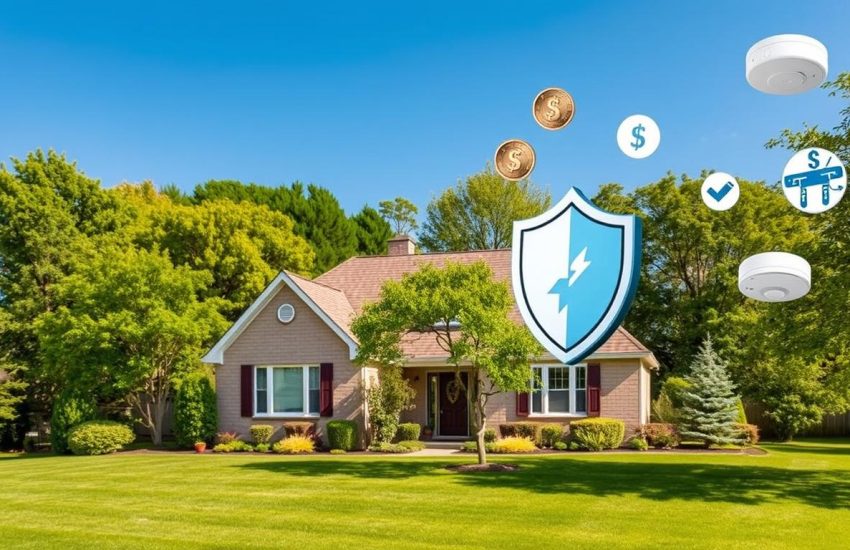The Ultimate Guide to Installing Gutters on a Budget
Ever thought about how to save money and still protect your home with gutters? Few know they can cut costs by doing the job themselves. The average cost is between $2 and $6 for each foot. But, top-notch materials can go over $20 a foot. Knowing the right stuff can really help you spend less on keeping your home safe.
Gutters keep your home safe by moving rainwater away. This stops water damage and leaks. Though it seems tough, you can find everything you need at local stores. Greg Nemec of Classic Gutter Systems says doing it yourself is smart. It makes your home work better and look nicer.
Key Takeaways
- Understanding the importance of correct gutter slope to ensure optimal drainage, typically ½ inch per 10 feet.
- Familiarizing yourself with common gutter materials and sizes, including cost-effective options like aluminum.
- Strategies for reducing clogs and maintenance through prudent placement of downspouts and the use of gutter guards.
- Insights into the average costs of gutters and accessories, helping you plan your budget.
- Guidance on when DIY gutter installation is feasible and when to consider professional help.
Choosing the Right Gutter Material
Choosing gutters for your home means looking at style and how it works in your weather. Gutters can be cheap, like vinyl, or fancy like copper. Each kind has its own good and bad points. Knowing these helps you pick better and save money.
Aluminum gutters are light and don’t rust, making them a good cheap choice. You can paint them to match your house. But, they might dent easy. In places with lots of snow, steel gutters are better because they’re strong. Yet, they can rust if you don’t care for them right.
Vinyl gutters are great because they don’t rust and are easy to put up yourself. They work best in warm places but can break in the cold. Copper or zinc gutters last a long time and look nice as they age. They don’t need much work to keep up.
Want tips on how to save money on these materials? Read about home improvement deals. These gutter repair tips will help keep them in good shape, saving you repair costs.
| Material | Pros | Cons | Cost | Maintenance |
|---|---|---|---|---|
| Aluminum | Lightweight, rust-resistant, paintable | Dents easily | Budget-friendly | Regular checks for dents and damage |
| Vinyl | Corrosion-resistant, DIY-friendly | Less durable in cold | Very affordable | Checks for brittleness and cracks in cold |
| Steel | Highly durable, ideal for harsh weather | Prone to rust | Moderate | Rust prevention treatments |
| Copper | Long lifetime, low maintenance, patina | Higher cost | Premium | Minimal; patina care |
| Zinc | Durable, develops protective layer | Expensive, professional installation needed | High | Little to no maintenance needed |
Picking the right gutter system is key for your home’s outside look and how it handles rain. The best choice means fewer repairs and a better gutter system. It’s important to match your gutters to what you need and can afford. This leads to saving money and being happier in the long run.
DIY Gutter Installation Tips
Starting a DIY gutter installation project can save money. It also keeps your home safe from water damage. Here’s a simple guide for putting in gutters, with useful advice.
First, measure how long your roof is to know how much gutter you need. If your patio roof is 16 feet, plan for enough gutter coverage. You can buy gutters in 10-foot pieces from most stores, and two sections usually work well.
Put downspouts in the right places. They should be about one foot off the ground. This helps move water away from your house. Use 3″ x 4″ aluminum elbows to point the downspouts away. This stops water from pooling and protects your home’s foundation.
Using the Right Tools and Materials
- Make sure to have solid ladders, gloves, and drills.
- Keep various screws and gutter sealants handy.
- Get caulking guns and tin snips for clean cuts and seals.
Choose gutter sizes based on your roof’s slope and area. Big downspouts are best for places with lots of rain or steep roofs. A good gutter slope — down 1/4 inch for every 10 feet — helps water flow well, avoiding overflows and clogs.
| Tool/Material | Function |
|---|---|
| Caulk & Caulking Gun | Seals joints and stops leaks |
| Screwdriver & Screws | Keeps gutter brackets in place |
| Tin Snips | Cuts gutters to the right size |
| Ladder | Lets you reach high places safely |
For the best outcome, place hangers evenly across the roofline. They keep gutters straight. Don’t space them out more than 30-40 feet, depending on your gutter size and the weather. This helps share the weight and makes gutters last longer.
In the end, make sure everything is connected well and the sealant has dried. Checking and taking care of your gutters often will keep your home safe for a long time.
How to Save on Labor Costs
Looking at affordable gutters?
One key area to save is on labor costs. They often form a big part of the total expense. Here are some useful gutter repair tips. These strategies help control costs without losing quality.

Choosing DIY for gutter installation can save money. First, mark the layout lines for the gutters. Attach the fascia brackets in line with the rafters.
Then, use a hacksaw, drill, and rivet gun. This is for cutting, drilling, and assembling the gutters. Make sure the gutters tilt towards the downspout. This step is very important. It ensures effective water flow. Plus, it helps avoid future repair costs from water damage.
- Use siliconized caulk to seal all joints to avoid leaks and offer long-term durability.
- Opt for appropriate fasteners to securely attach the gutter to the brackets, fostering stability and diminishing the risk of detachment.
- Paint aluminum gutters and brackets to match your house trim for a seamless aesthetic appeal at minimal costs.
- Install concrete pavers under downspouts as a budget-friendly solution for better rainwater management and to reduce soil erosion near your home’s foundation.
Learning about different gutter materials helps a lot. This link guides on savings during gutter installation.
This lets you know what you can do yourself. It shows what might need a pro. This knowledge leads to smart choices. These fit both your skills and budget.
Clean the gutters twice a year to save more in the long run. Check regularly for damage or wear. This reduces the need for big repairs or total replacements. Pay extra attention after bad weather as it can cause more damage to gutters.
While DIY can cut costs now, correct installation is crucial. This avoids pricey issues later on. For tough jobs, or if unsure, getting a pro could save money. It is also safer.
Common Mistakes to Avoid
When talking about gutter installation, knowing and avoiding common mistakes matters a lot. This keeps your home’s drainage working well. Let’s look at some big errors to avoid.
- Improper Slope: Gutters need a slope of one-quarter inch every 10 feet for good water flow. Without this slope, water can pool, overflow, and damage your system.
- Incorrect Hanger Placement: Hangers no more than 2 feet apart stop the gutters from sagging. This is very important when there’s a lot of snow or rain.
- Substandard Material Choice: Aluminum gutters are great for their durability and price. However, picking cheap materials can cause you to often repair or replace them, raising costs over time.
- Seam Errors: Going for seamless gutters is smart because they leak less and need less upkeep than sectional ones.

Putting gutters too close to the roof edge is yet another mistake. This can make water spill over rather than drain, harming the fascia boards. For more tips and help on keeping your home’s outside in good shape, check out this seasonal home maintenance guide.
| Feature | Recommended | Common Mistake |
|---|---|---|
| Gutter Slope | 1/4 inch per 10 feet | No slope/Low slope |
| Material Choice | Aluminum, Copper | Cheaper plastics |
| Installation | Use of professionals | DIY without proper tools or knowledge |
| Maintenance | Regular cleaning with guards | Ignoring clogs and leaks |
A smart gutter installation makes your home look better and protects it from water harm. Getting help from a pro can ensure your home gets what it needs. This way, everything about the installation and upkeep is done right.
When to Call a Professional
DIY projects can help you save on home maintenance. But, for gutter installation, knowing when to get a pro is key. It’s about your safety and your home’s health. Seeing water damage? That means rain isn’t flowing away right. Needing a pro is clear if gutters sag, come loose, or leak during storms.
How often and how big the repairs are can help decide your budget. Homeowners usually spend 1% to 4% of their home’s value on upkeep each year. This includes gutters. A pro’s help with gutter troubles is very important. Wrong gutter placement or downspout issues can cost a lot later. A pro can fix these problems fast and well, saving you money and future headaches.
It’s key to find a trustworthy contractor for quick fixes or new gutters. Pros have the tools, the know-how on materials, and skills that DIY fans don’t. An inch of rain can really test a weak gutter system. So, a pro installed system is best for peace of mind and your home’s safety. It keeps your home safe from water damage and mold. Make sure any contractor you pick gives you a clear written quote, has the right license, and insurance. This makes sure the job is done right and safely.



